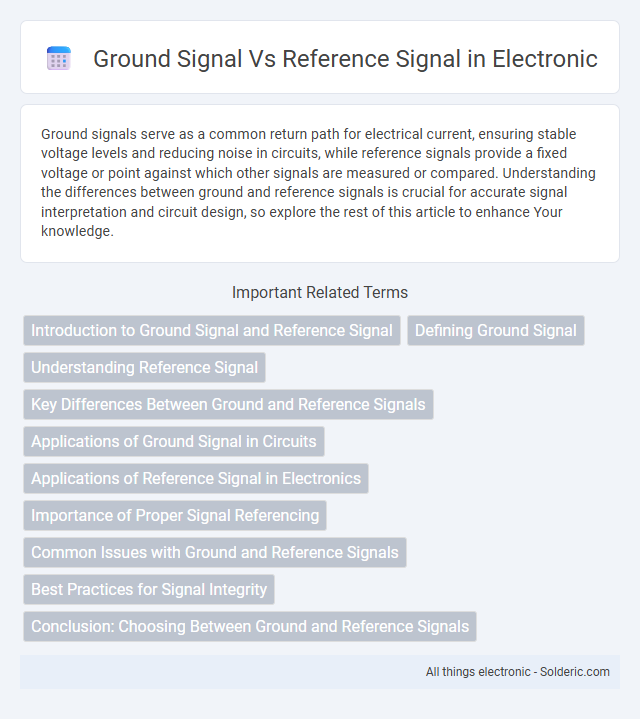Ground signals serve as a common return path for electrical current, ensuring stable voltage levels and reducing noise in circuits, while reference signals provide a fixed voltage or point against which other signals are measured or compared. Understanding the differences between ground and reference signals is crucial for accurate signal interpretation and circuit design, so explore the rest of this article to enhance Your knowledge.
Comparison Table
| Feature | Ground Signal | Reference Signal |
|---|---|---|
| Definition | Baseline electrical potential at zero volts, used as a common return path in circuits | Stable, known signal used for calibration or comparison in signal processing |
| Purpose | Provide a stable zero voltage reference point for circuit operation and safety | Enable accurate measurement, synchronization, or calibration against a known standard |
| Typical Usage | Circuit common return, safety earth connection | Calibration signal, phase or frequency reference in communication systems |
| Voltage Level | 0 V (zero volts) | Varies depending on application and standard reference |
| Signal Stability | Assumed stable zero potential | Precisely controlled and stable for accuracy |
| Examples | Chassis ground, earth ground | Clock signals, standard waveform generators |
Introduction to Ground Signal and Reference Signal
Ground signals serve as a common return path for electrical current and establish a zero-voltage reference point in circuits, ensuring stable operation and noise reduction. Reference signals provide a baseline voltage level used for measurement or comparison, crucial for accurate signal processing and system calibration. Understanding the distinction between ground and reference signals helps you design better circuits by managing voltage levels and minimizing interference.
Defining Ground Signal
Ground signal serves as the zero-voltage reference point in an electrical circuit, establishing a common baseline for all voltage measurements. It is crucial for ensuring electrical stability and preventing noise interference by providing a path for return current. Understanding your system's ground signal helps maintain accurate sensor readings and reliable signal integrity in mixed-signal environments.
Understanding Reference Signal
Reference signals serve as stable benchmarks in various electronic systems, providing a consistent voltage or current level against which other signals can be measured or compared. Unlike ground signals, which represent the zero-voltage reference point or common return path, reference signals often maintain a precise, predefined potential essential for accurate sensor readings, communication protocols, and analog-to-digital conversions. Your ability to distinguish between ground and reference signals ensures improved circuit stability and measurement accuracy in complex electrical designs.
Key Differences Between Ground and Reference Signals
Ground signals serve as the common return path for electrical currents and are typically connected to the earth, ensuring safety and noise reduction in circuits. Reference signals provide a stable voltage point for measuring or controlling other signals, often used as a baseline in analog and digital systems. Your accurate analysis of electronic circuits relies on understanding these key differences to minimize interference and improve signal integrity.
Applications of Ground Signal in Circuits
Ground signals serve as the essential reference point for voltage levels in electronic circuits, ensuring accurate signal measurements and stable operation. They provide a common return path for electric current, which is critical in minimizing noise and interference in sensitive analog and digital systems. Applications of ground signals include stabilizing power supplies, enabling proper operation of sensors and transducers, and facilitating reliable communication between circuit components.
Applications of Reference Signal in Electronics
Reference signals in electronics provide stable voltage or frequency benchmarks used for calibration, synchronization, and error correction in systems such as oscillators, communication receivers, and data converters. Unlike ground signals that serve as a common return path for current, reference signals ensure consistency and accuracy in measurements and signal processing. Precise applications include phase-locked loops (PLLs), analog-to-digital converters (ADCs), and frequency synthesizers for maintaining signal integrity.
Importance of Proper Signal Referencing
Proper signal referencing is crucial to minimize noise and interference in electronic circuits, ensuring accurate data transmission and signal integrity. Ground signals serve as a common reference point, while reference signals provide stable voltage levels for measurement or comparison, directly affecting circuit performance and reliability. Incorrect grounding or referencing can lead to signal distortion, measurement errors, and system malfunctions, emphasizing the need for precise signal referencing techniques in electronics design.
Common Issues with Ground and Reference Signals
Ground and reference signals often face common issues such as ground loops, noise interference, and voltage offsets that can degrade signal integrity. Improper grounding can cause unwanted current paths, resulting in signal distortion and measurement errors in sensitive electronic systems. To ensure accurate readings and system stability, you must carefully design the grounding and referencing scheme to minimize these disturbances.
Best Practices for Signal Integrity
Ground signals and reference signals must be properly managed to ensure optimal signal integrity in electronic circuits. Maintaining a low-impedance ground plane and minimizing the loop area between the signal and reference path reduces electromagnetic interference and crosstalk. Your layout should prioritize close proximity between ground and reference signals, use proper decoupling capacitors, and avoid ground loops to prevent noise and signal degradation.
Conclusion: Choosing Between Ground and Reference Signals
Ground signals serve as a common return path for electrical currents, ensuring safety and minimizing interference, while reference signals provide stable voltage baselines for accurate measurements and signal processing. Your choice depends on the application's needs for noise reduction, measurement accuracy, and system design complexity. Understanding the distinct roles of ground and reference signals helps optimize circuit performance and reliability.
ground signal vs reference signal Infographic

 solderic.com
solderic.com